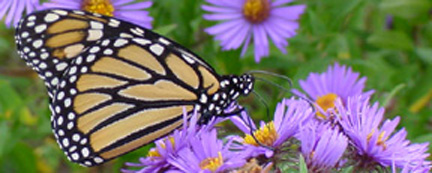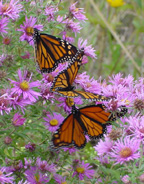Monarch Butterfly Migration Over Central Iowa in Fall 2002
By Robert D. Woodward
In mid-August, the first signs of migrating monarch butterflies began in central Iowa. The summer of 2002 was somewhat disappointing in the sense that the monarch butterfly population appeared to be down considerably in central Iowa--at least judging from field observations. Check back regularly to see the field reports on the monarch migration.
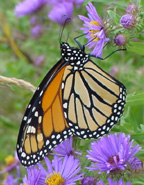
August 23, 2002--Stirrings of a fall migration! During an hour afternoon visit to the Neal Smith National Wildlife Refuge near Prairie City, Iowa, 24 monarch butterflies were observed flying over the prairie and feeding on the flowers. At this time of the year, the thistles are a predominant element on the prairie, and they were attracting monarchs and the many swallowtails that were observed. Other wildflowers blooming now are the cardinal flower, goldenrod, Jerusalem artichoke, horsemint, vervain, and Queen Anne's lace. It was interesting to note that the tickseed sunflowers--a major attraction for last year's migrating monarch butterflies--were just beginning to bloom. Several monarchs already were nectaring on those flowers.
August 24, 2002--Where are the red admirals? Why were the numbers monarchs down considerably this summer? The red admirals have been prominent in our butterfly garden every summer until this year, when their appearances have been quite rare. A University of Kansas expert told the Associated Press that the weather conditions over the winter and into the spring may have contributed to lower butterfly numbers in Kansas. The same appears likely in Iowa. It's interesting that the numbers of swallowtails have been consistently strong, however,
August 25, 2002--Another visit to Neal Smith National Wildlife Refuge turned up only eight monarchs in the late afternoon. Several mimics--the viceroy--sought to get into the count, but it didn't work. A lone monarch nectaring on a thistle on a hillside created a nice late afternoon shadow against the cloudy sky.
August 30, 2002--Monarch activity in and around our butterfly garden in Altoona, Iowa, is minimal. Three or four monarchs are the most that have been observed at any one time in recent days.
August 31, 2002--During an hour and one-half visit to Neal Smith National Wildlife Refuge, 56 monarchs were counted. A year ago on the same date, the count was 400 to 500 in the same general areas over two hours. The monarchs this year were feeding primarily on thistles and tickseed sunflowers, which in the last week have come out in full bloom. Most of the 56 monarchs were singles, except for a flurry of monarchs nectaring on tickseed sunflowers in an area protected from a mild breeze.
September 1, 2002--Once again, the numbers of migrating monarchs were much lower than they were a year ago at Neal Smith National Wildlife Refuge. During two different visits to the refuge on this day in 2001, I observed at least 200 monarchs on each visit. This year, 33 monarchs were observed--mostly as singles. A southerly breeze was blowing, and the monarchs were spending their time nectaring on thistles and tickseed sunflowers.
September 2, 2002--Before leaving for a visit to Neal Smith National Wildlife Refuge, I observed a single monarch flying over our butterfly garden in Altoona, Iowa, at 8:55 a.m. The visit to the refuge turned up a few more monarchs than on the previous day with a count of 51. But once again, the count was down considerably from the 200 monarchs observed at the refuge on this day in the autumn of 2001. The wind was blowing from the south-southwest at 15 to 20 miles per hour, and the monarchs were keeping low to the ground. Standing on a prairie hilltop amidst tall thistles and big bluestem grass, I observed 14 monarchs in about 15 minutes. They were resting on plants close to the ground and feeding on the thistles. Some of the thistles are now as much as 8 feet tall, and the bluestem grasses are 5 to 6 feet.
September 3, 2002--During an hour visit to Neal Smith National Wildlife Refuge, 15 monarchs were observed nectaring on tickseed sunflowers,Jerusalem artichoke, and an occasional thistle.
September 4, 2002--A single monarch was observed roosting on a tree limb in our butterfly garden.
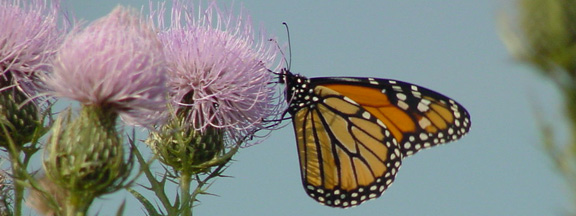
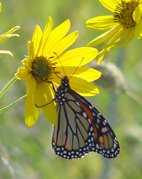
September 7,2002--A Saturday morning visit to Neal Smith National Wildlife Refuge turned up 65 monarchs in 1 1/2 hours. The monarch activity was heavier than in recent days but still did not measure up to the totals being seen last autumn. Tickseed sunflowers and thistles continued to serve as the main feeding stations.
Later in the morning, a 20-mile drive along secondary roads in Iowa turned up a single monarch crossing the roadway. Normally, at this time of year, the migrating monarchs are regularly seen along the state's roadways.
Back in our butterfly garden in Altoona, Iowa, the first native asters are beginning to bloom. The initial blooms often coincide with an increase in the number of monarchs passing through and/or stopping for an overnight stay in the butterfly garden. This year, the activity has been minimal so far.
September 8, 2002--An hour visit to Neal Smith National Wildlife Refuge in the late morning turned up 23 monarch butterflies feeding on thistles and tickseed sunflowers.
September 9, 2002--The weather in central Iowa continued to be unseasonably warm with a high of 90 degrees in Des Moines. But a cold front was moving in from the northwest, and by Tuesday, the weather should be changing. Will the front bring more migrating monarchs with it?
September 10, 2002--A wonderful day. The cold front was passing through the state, and by late afternoon, migrating monarchs were riding and floating on the wind on their southward journey. In 45 minutes--from 5:15 p.m. to 6 p.m.--150 monarchs were counted high in the sky flying over our butterfly garden in Altoona, Iowa. They came so fast at times that the count certainly was conservative. Some of the monarchs could be seen with the naked eye, but this was a day when binoculars were needed to experience the magnitude of the event. On the drive home from the Drake University campus, I observed at least 15 monarchs--many crossing the roadways where none had been seen for days. In our monarch garden, monarchs could be seen flying over the autumn flowers at the end of the day.
September 11, 2002--The cold front earlier this week definitely stepped up the pace of the monarch migration through central Iowa. Monarchs could be seen throughout the day migrating across the campus of Drake University in Des Moines. During a visit to Neal Smith National Wildlife Refuge, I observed at least 125 monarchs during a 2 1/2-hour visit in the late afternoon. A highlight was watching 25 to 30 monarchs nectaring on a large stand of Jerusalem artichokes. Some of the plants are now more than 10 feet tall, and the monarchs were flying around the flowers and feeding, their outlines making a beautiful picture against the autumn sky. The silence and solitude of the surroundings fit well with the day of national remembrance concerning the 9/11 tragedy.
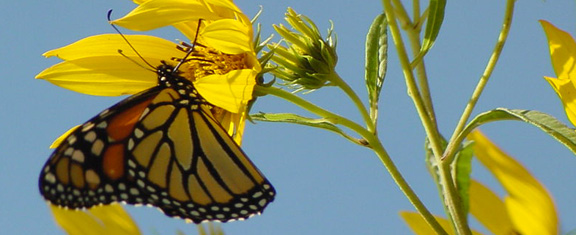
September 12, 2002--Another visit to the Neal Smith National Wildlife Refuge meant an opportunity to see more migrating monarchs. The large stand of Jerusalem artichokes in the northern part of the refuge was a popular feeding place for monarchs for the second straight day. More than 80 monarchs were counted in that area in less than an hour's time. During a one-hour visit from 4:15 p.m.to 5:15 p.m., more than 90 monarchs were seen overall. Monarchs also were being seen regularly along the Iowa roadways and passing over the fields.
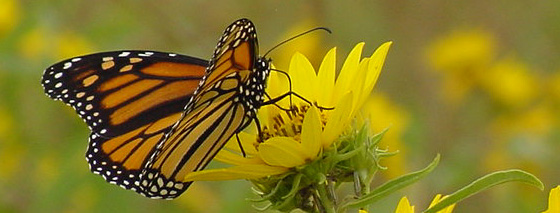
September 13, 2002--This Friday, the monarch migration appeared to be nearing its peak through central Iowa, judging from anecdotal observations. During 2 1/2 hours of observations from 2:15 p.m. to 4:45 p.m., 310 monarchs were counted nectaring on primarily Jerusalem artichokes along the roadway leading through Neal Smith National Wildlife Refuge. A stand of Jerusalem artichokes in the north part of the refuge continued to be a popular stopping point for migrating monarchs, but further into the refuge, several other major stands of Jerusalem artichokes produced many more monarchs. The day was partly cloudy with a mild breeze from the south southeast, but as the afternoon passed, the breeze diminished. The movement of the monarchs from plant to plant was a riveting sight. Tickseed sunflowers and thistles had been major attractions a week ago, but now the Jerusalem artichokes were clearly the favored place to feed.
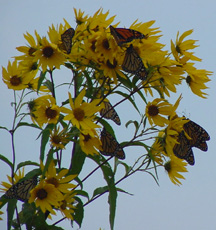
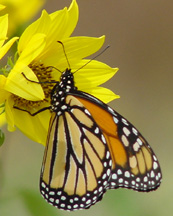
September 14, 2002--Saturday was another great day for monarch watching. Upon arrival at Neal Smith NationalWildlife Refuge at 8:45 a.m., I noted groups of monarchs appeared to be roosting on several of the tallest Jerusalem artichokes. A light rain had been falling earlier in the morning, and the monarchs were clustered at the tops of Jerusalem artichokes and down in the tall big bluestem grasses. As the sun came out from time to time from under the clouds, the monarchs could be seen sunning their wings and opening and closing them. During the morning, there was continual monarch movement in the refuge, and in 3 1/2 hours, at least 415 monarchs were observed. At one point late in the morning, the wind shifted from the south southeast to the northwest, and the breeze brought a flurry of monarchs racing across the prairie for several minutes.
September 15, 2002--The day was clear and cool, and the number of monarchs appeared to be down from the past two days. During two hours at Neal Smith National Wildlife Refuge, 37 monarchs were counted between 8:15 a.m. and 10:15 a.m. No monarchs were seen along the roadways during the drive to and from the refuge. A single monarch was seen passing through our butterfly garden later.
September 16, 2002--Monarchs were on the move in the morning across the Drake University campus and roadways of central Iowa. A friend reported having seen a number of monarchs around Saylorville Lake north of Des Moines on Sunday.
September 17, 2002--Seventy-five monarchs were observed from 1 p.m. to 3 p.m. in the Neal Smith National Wildlife Refuge. The monarchs were struggling against a strong breeze from the southeast and appeared to be nectaring exclusively on the Jerusalem artichokes. They were clinging to the flowers as the plants swayed in the wind. Elsewhere across central Iowa , I saw at least 15 more monarchs during the day.
September 19, 2002--Following the passage of another cold front and a cool rain, this was another great day for observing the monarch migration at Neal Smith National Wildlife Refuge. From 3:45 p.m. to 6 p.m., 225 monarchs were observed flying across the prairie and feeding on the flowers. Particularly interesting was the fact that the native purple asters were in full bloom, and the monarchs were making the flowers a favored feeding place.
September 20, 2002--The monarchs were on the move again. A wind from the west stirred up the monarch movements, and in an hour, I counted more than 80 monarchs flying, floating, and speeding on the wind to the east southeast across the prairie at Neal Smith National Wildlife Refuge. After observing the passage of the monarchs at a specific point in the northern part of the refuge, I then sought out feeding areas. Overall, in three hours from 10:50 a.m. to 1:50 p.m., 252 monarchs were counted during the observations.
September 21, 2002--How quickly things change during the monarch migratory season. On this day during a one-hour visit from 1:15 p.m. to 2:15 p.m. at Neal Smith National Wildlife Refuge, I observed only a single monarch flying across the prairie after several days of seeing many in the same environment.
September 22, 2002--No migrating monarchs were observed throughout the day.
